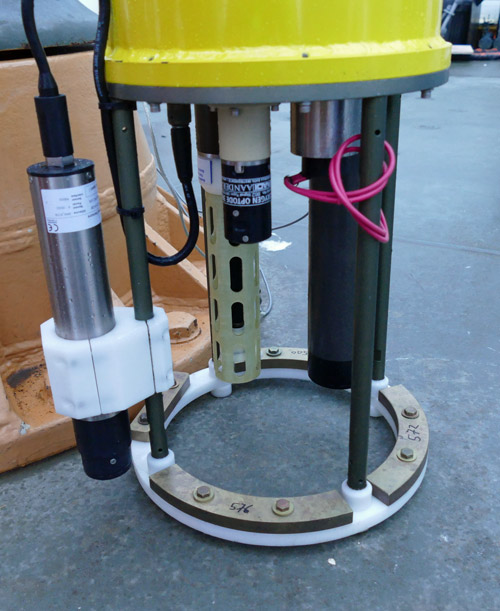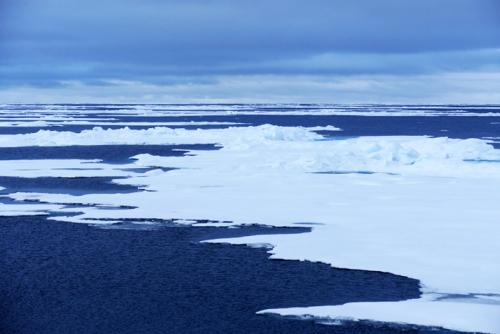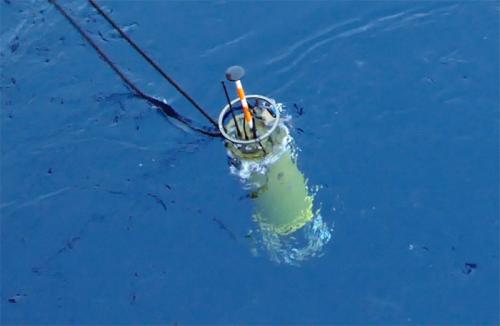Cruise Day 14
Speed 1 knot (kts) (on station)
Course 350° (N)
Location S Mendelev Rise, approx. 392 nm N of Wrangel Island, Russia
Depth 985 m
GO DEEPER DISCUSSION: (see previous journal for the questions.)
Even when we are stopped for a science station we are slightly moving. The ship’s movement, just like the ice around us, is affected by wind and current. Notice that when we are on station we are often moving about 1 nautical mile per hour (kt) over the seabed, even though it seems we are standing still when I look at the water around us. We also slightly repositioned the ship about halfway through the last full station when ice floes were crowding in, moving to a more open patch of water to complete our sampling.
TODAY’S JOURNAL:
We’ve had an interesting piece of gear strapped to the rail on the fantail since we departed Dutch Harbor. It looks like a big yellow tube sprouting a couple of antennas with various instruments attached and an upward-looking camera riding on the top. Called an Allen Float, it is a a type of autonomous buoy, very similar to an Argo Float (search for this online for more details.) These devices are like robotic drifting submarines that sink to a “parking depth” (typically 1000 meters), and move on deep currents for a pre-determined interval. Then they sink deeper and finally slowly rise to the surface, building a temperature & salinity profile vs. depth as they rise. Their buoyancy is controlled by a piston that can expand and contract the volume of an internal chamber, allowing the float to fine-tune its density for it to hover, sink, or rise as desired. Once they reach the surface they re-acquire their position via GPS and upload the data accumulated since the last surfacing by satellite.
 The bottom of the Allen float has instrumentation similar to our sampling rosettes including a CTD (center, with ventilated housing) and a visual radiometer (cylinder in white plastic mount on left.)
The bottom of the Allen float has instrumentation similar to our sampling rosettes including a CTD (center, with ventilated housing) and a visual radiometer (cylinder in white plastic mount on left.)
Last night just after midnight I got paged that we were going to launch it at the end of the short sampling station that was underway, so I suited up, headed out, and watched the process. This new type of float is being developed for use in the Arctic by the University of Washington, and they sent along the device to deploy when we hit about 50% ice coverage.
 Ice coverage is nearing 50% as we progress north, a target level for deploying the Allen Float.
Ice coverage is nearing 50% as we progress north, a target level for deploying the Allen Float.
One piece of gear it boasts is a GoPro camera that looks upward as it nears the surface to look for openings in the ice so it won’t bump up against that unforgiving ceiling. It also has an upward-looking sonar altimeter to carefully measure the distance remaining to the ice cover. It has a CTD unit on the bottom for salinity & temperature profiling, and a pair of visual radiometers, one facing upward and the other downward, to measure light levels. Another cool feature is an exploding bolt that can release the weighted bottom ring if the float seems to be stuck and unable to rise. When the weighted ring is ejected, the whole unit will float no matter what the state of the buoyancy chamber.
 This deep water housing contains a GoPro camera which the Allen Float uses to find open water in the Arctic to surface in.
This deep water housing contains a GoPro camera which the Allen Float uses to find open water in the Arctic to surface in.
To prepare the Allen Float for launch, the device was first hooked up to a laptop computer and turned on using a magnetic switch. A simple program initiated the data systems onboard, acquired the first GPS location fix, and let the scientists back at the University of Washington check to see that the unit was transmitting properly. Then the device was lowered into the ocean where it began gently sinking to its first parking depth.
 Paul Aguilar turns on the Allen Float by holding a magnet over the magnetic on-switch inside the yellow housing.
Paul Aguilar turns on the Allen Float by holding a magnet over the magnetic on-switch inside the yellow housing.
 Mark Stephens calls the University of Washington using a satellite phone to confirm steps to take for preparing the Allen Float’s deployment.
Mark Stephens calls the University of Washington using a satellite phone to confirm steps to take for preparing the Allen Float’s deployment.
 Bon Voyage & Bonne Chance, little Yellow Submarine!
Bon Voyage & Bonne Chance, little Yellow Submarine!
GO DEEPER!
I’ll leave you with a riddle today- can you solve it?
I look flat, but I am deep. Hidden realms I shelter. At times I am beautiful. I can be calm, angry, and turbulent. I have no heart, but offer pleasure as well as death. No person can own me, yet I encompass what all people must have.
Aloft Con web cam updated every hour
Healy Track
That's all for now. Best- Bill


Comments